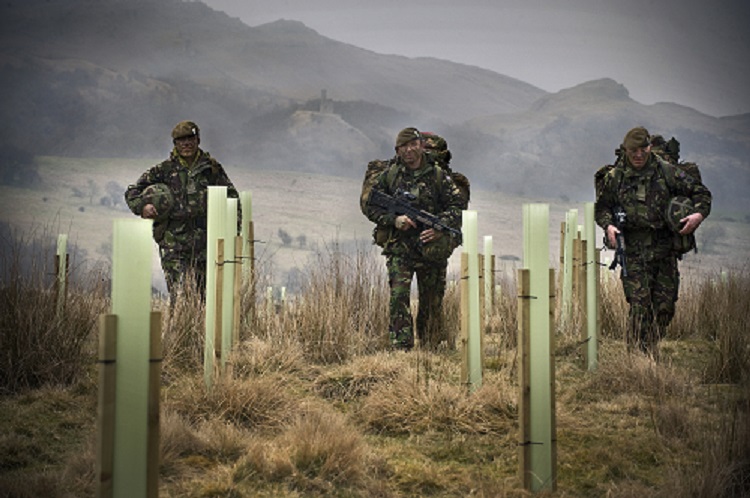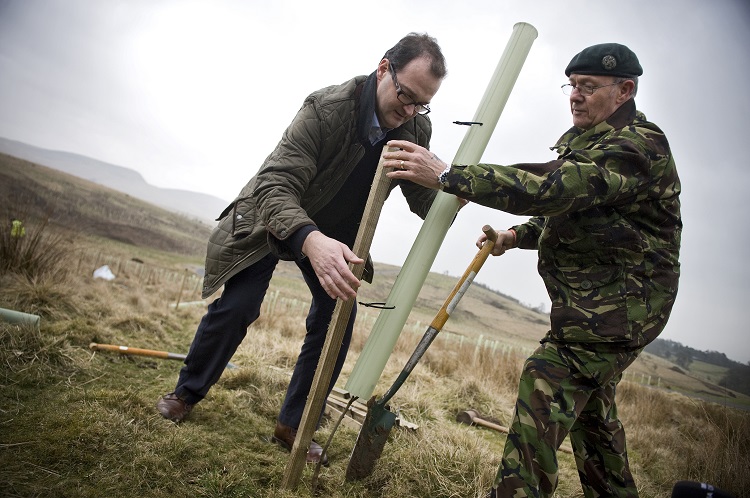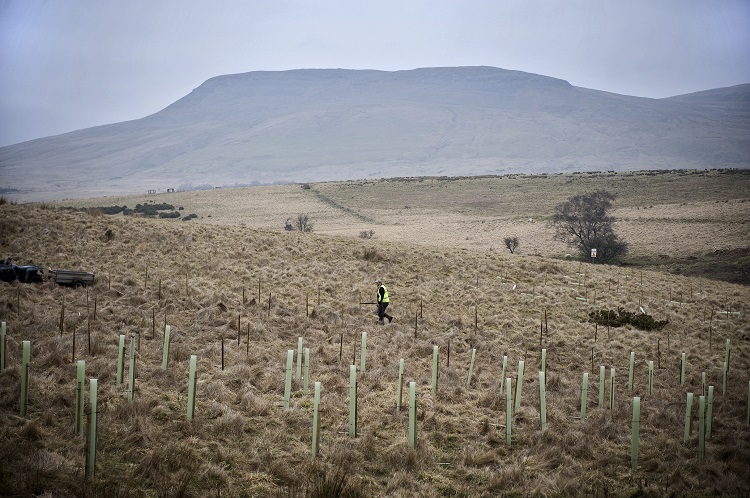Warcop
Summary
About the site
Carbon Buyers - Why buy from this project?
Landowners - Why get involved in the WCC?
Who is involved?
How we go about it
Wider benefits
Summary
Unique ID: 103000000004454
Status: Validated/ Active
Project Developer: Woodland Trust
Project Location: Warcop, Eden Valley, Cumbria
Previous Land Use: Unimproved grassland with sheep grazing
New woodland: Gross area: 160ha Planted area: 160ha Open ground: 0ha
Species Mix: 30% Ash, 21% Oak, 12% Rowan, 9% Aspen, 6% Wild Cherry, 22% other native broadleaves
Woodland Management: Minimum intervention
Estimated Sequestration: 90,382 tCO2e over 100 years
Start Date: 2011
About the site
The project is located on the Ministry of Defence (MOD) owned Warcop Training Area, in the Eden Valley, Cumbria. A limestone escarpment splits the 9,550ha site. Grass moorland and blanket bog cover the plateau above the escarpment, whilst a more wooded area forms the landscape below. Warcop Training Ground includes many conservation designations. Almost the entire training area lies within the North Pennines Area of Outstanding Natural Beauty (AONB). Other areas within the site have Site of Special Scientific Interest (SSSI) or Special Area of Conservation (SAC) status.
 Soldiers walk through new woodland at Warcop, Cumbria, in 2011. Photo: Woodland Trust
Soldiers walk through new woodland at Warcop, Cumbria, in 2011. Photo: Woodland Trust
Carbon Buyers - Why buy carbon from this project?
The Woodland Trust has underwritten the first phase of the project on the basis of the anticipated return through sale of the carbon. Waitrose and Eurocamp have bought already bought carbon from this project. The North Pennines Area of Outstanding Natural Beauty has also contributed match funding and is a valued partner in the project.
Landowners - Why get involved in the WCC?
The project’s key aims are to provide the Ministry of Defence with enhanced training facilities and to sequester carbon. The carbon sequestration potential for the site has been assessed and it is envisaged that corporate funding through the purchase of the carbon “rights” will enable woodland creation to take place without the need for a Woodland Creation Grant. The project would not be happening without carbon finance.
Defence Estates Deputy Chief Executive David Olney said: “Supporting our Armed Forces is the top priority for Defence Estates. We are delighted to join forces with the Woodland Trust and respond to military training needs in providing woodland cover which will benefit soldiers preparing for operations. This excellent initiative allows us to improve training facilities, whilst securing significant conservation and environmental benefits at no extra cost to the Ministry of Defence.”
Stuart Dainton, head of partnerships at the Woodland Trust commented: “Our partnership with the MOD will play a significant role in helping to increase woodland cover in the UK, currently one of the lowest in Europe. It is a great example of working together, and whilst organisations have different motivations, ultimately everyone involved has benefited from the planting of trees.”
 Stuart Dainton, Head of Partnerships, Woodland Trust, plants a tree with North-Comndt Regional Officer WTA (Tam Campbell) in 2011. Photo: Woodland Trust
Stuart Dainton, Head of Partnerships, Woodland Trust, plants a tree with North-Comndt Regional Officer WTA (Tam Campbell) in 2011. Photo: Woodland Trust
Who is involved?
The Warcop Training Area pilot scheme was co-developed between the Ministry of Defence, who wished to develop new woodlands within its training areas; the Woodland Trust, who have knowledge of woodland creation and management; and retail companies wishing to mitigate for unavoidable greenhouse gas emissions. The sale of sequestered carbon and a significant funding contribution from North Pennines AONB allowed the project to be 100% financed from funding sources not traditionally associated with woodland creation.
How did we go about it?
We've talked to a lot of local people, stakeholders and statutory bodies and we know that there's a lot of support for the project, especially among the farming community, which is reassured that the presence of the trees will not limit the potential for grazing sheep in the future.
The Woodland Trust will manage the site for ten years in the first instance and retain the option to continue management thereafter. The woodland will be managed primarily to maintain cover for training purposes.
We've used the tables provided by the Forestry Commission and have estimated that a total of 90,382 tonnes of CO2e available for sale. Over the project's lifetime this sequestration of carbon dioxide we will be monitored using Carbon Assessment Protocol Method B for broadleaved woodlands.
 Warcop Training Area in February 2011. First phase of planting.
Warcop Training Area in February 2011. First phase of planting.
What are the wider benefits?
The new woodland which is near to the A66 should make views of the landscape from nearby more interesting. Also parts of the training estate offer valuable sanctuary to species such as black grouse, which will benefit from the presence of more trees. Creating more woodland in the area will increase its ability to reduce the severity of local floods and stabilise soils when it rains hard. There have been and will continue to be significant community benefits from the project with hundreds of hours of volunteer work being donated. In the longer term there might be opportunities for harvesting of wood fuel, which will benefit the local community and further reduce fossil carbon emissions.

